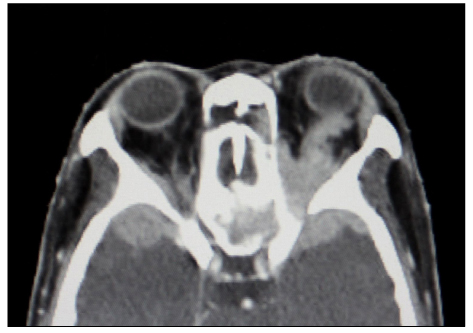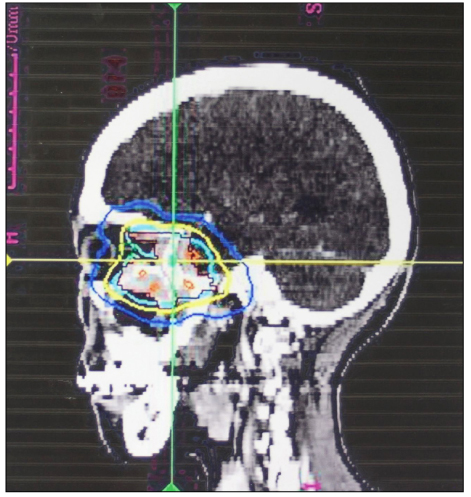J Korean Ophthalmol Soc.
2012 Aug;53(8):1208-1211. 10.3341/jkos.2012.53.8.1208.
Treatment of Compressive Optic Neuropathy by Recurred Maxillary Cancer Using Stereotactic Radiosurgery: A Case Report
- Affiliations
-
- 1Department of Ophthalmology, Korea Institute of Radiological & Medical Sciences, Seoul, Korea. cedere@hanmail.net
- 2Department of Neurosurgery, Korea Institute of Radiological & Medical Sciences, Seoul, Korea.
- KMID: 2215970
- DOI: http://doi.org/10.3341/jkos.2012.53.8.1208
Abstract
- PURPOSE
To report a case of a female patient treated with stereotactic radiosurgery for compressive optic neuropathy by recurred maxillary cancer.
CASE SUMMARY
A 51-year-old woman with a history of maxillary cancer presented with decreased visual acuity and visual field and color vision defects in the right eye. The CT scan revealed a wide spread mass along the ethmoid sinus, orbit, optic canal, and skull base. Under the impression of compressive optic neuropathy, stereotactic radiosurgery was performed. A cumulative dose of 39 Gy in 3 daily fractions of 13 Gy was administered to the mass. After 10 days, visual acuity, color vision, and visual field improved and were maintained after a 2 month follow-up.
CONCLUSIONS
Stereotactic radiosurgery could be another treatment option for patients with compressive optic neuropathy caused by a malignant tumor.
Keyword
MeSH Terms
Figure
Reference
-
1. Adler JR Jr, Chang SD, Murphy MJ, et al. The Cyberknife: a frameless robotic system for radiosurgery. Stereotact Funct Neurosurg. 1997. 69(1-4 Pt 2):124–128.2. Adler JR Jr, Gibbs IC, Puataweepong P, Chang SD. Visual field preservation after multisession cyberknife radiosurgery for perioptic lesions. Neurosurgery. 2006. 59:244–254.3. Pham CJ, Chang SD, Gibbs IC, et al. Preliminary visual field preservation after staged CyberKnife radiosurgery for perioptic lesions. Neurosurgery. 2004. 54:799–810.4. Zada G, Yu C, Pagnini PG, et al. Early decreased tumor volume following fractionated Gamma Knife Radiosurgery for metastatic melanoma and the role of "adaptive radiosurgery": case report. Neurosurgery. 2010. 67:E512–E513.5. Tishler RB, Loeffler JS, Lunsford LD, et al. Tolerance of cranial nerves of the cavernous sinus to radiosurgery. Int J Radiat Oncol Biol Phys. 1993. 27:215–221.6. Leber KA, Berglöff J, Pendl G. Dose-response tolerance of the visual pathways and cranial nerves of the cavernous sinus to stereotactic radiosurgery. J Neurosurg. 1998. 88:43–50.7. Morita A, Coffey RJ, Foote RL, et al. Risk of injury to cranial nerves after gamma knife radiosurgery for skull base meningiomas: experience in 88 patients. J Neurosurg. 1999. 90:42–49.8. Stafford SL, Pollock BE, Leavitt JA, et al. A study on the radiation tolerance of the optic nerves and chiasm after stereotactic radiosurgery. Int J Radiat Oncol Biol Phys. 2003. 55:1177–1181.9. Hasegawa T, Kobayashi T, Kida Y. Tolerance of the optic apparatus in single-fraction irradiation using stereotactic radiosurgery: evaluation in 100 patients with craniopharyngioma. Neurosurgery. 2010. 66:688–694.10. Roh KW, Jang JS, Kim MS, et al. Fractionated stereotactic radiotherapy as reirradiation for locally recurrent head and neck cancer. Int J Radiat Oncol Biol Phys. 2009. 74:1348–1355.
- Full Text Links
- Actions
-
Cited
- CITED
-
- Close
- Share
- Similar articles
-
- Fractionated Stereotactic Radiosurgery(FSRS) for Sella and Parasella Tumors Adjacent to Optic Apparatus
- The Etiology of Optic Neuropathy
- A Case of Compressive Optic Neuropathy Caused by Sphenoid Sinus Mucocele
- Neovascular Glaucoma Following Stereotactic Radiosurgery for an Optic Nerve Glioma: A Case Report
- Stereotactic Body Radiotherapy for Early Stage Lung Cancer




